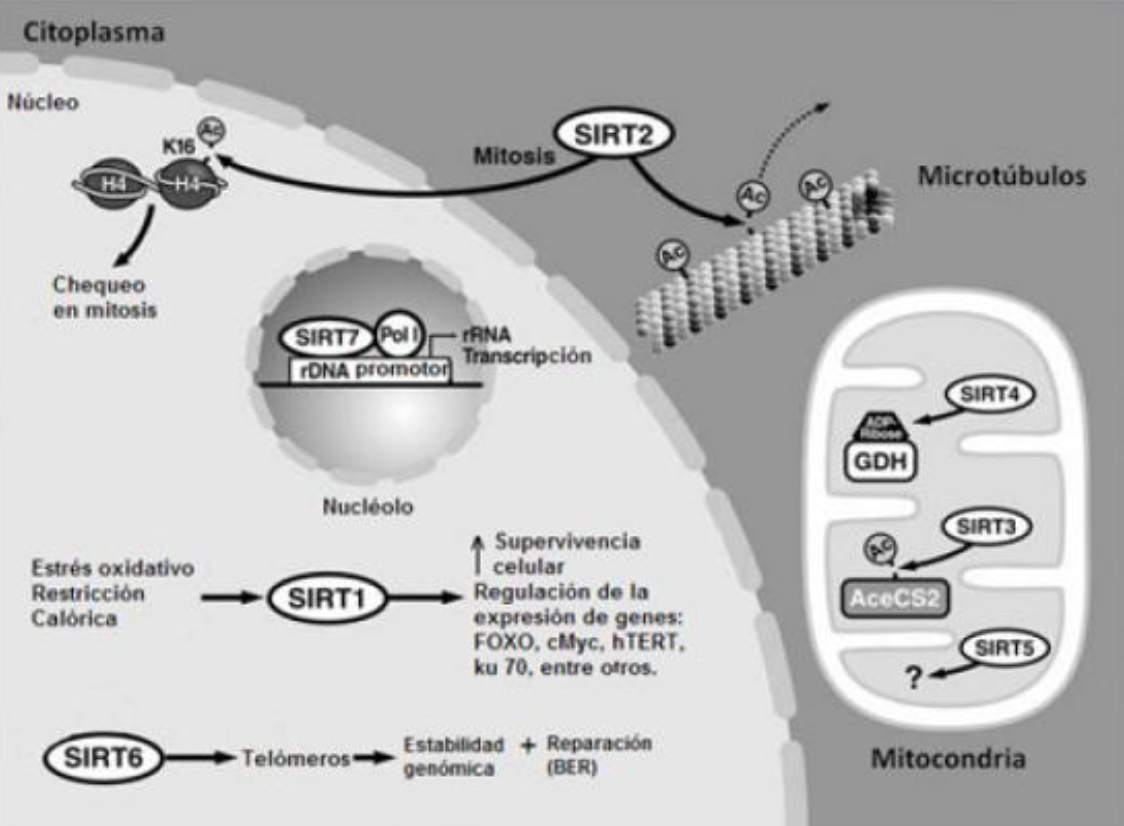If there is any enzyme group in our bodies that is related to longevity, it would be sirtuins.
These enzymes have been investigated for many years and have been associated in particular with delayed aging and longevity. . According to research conducted by Libert, there are different compounds in foods that activate the production of these enzymes.
Francisco Martínez Milla – Neolife Nutrition Unit
There are foods that activate the production of these enzymes, specifically stimulating SIRT1, the gene that encodes these proteins, which in turn have an anti-inflammatory and metabolic-enhancing effect in situations of obesity and glucose intolerance.
Sirtuins (SIRTs) are a group of seven proteins found in the body that have been shown to regulate a variety of functions, including metabolism, inflammation, and lifespan, as documented in a study published in the Annual Review of Physiology by Sergiy Libert and Leonard Guarente of the Massachusetts Institute of Technology (USA).
This group of researchers promotes the massive consumption of foods that stimulate the formation of SIRT proteins in the body.
Low grade chronic inflammation
Inflammation is a strategy used by our body, through which the immune system mobilizes and initiates the process necessary for repair to occur. Under normal conditions the threat is eliminated, repair is completed, and anti-inflammatory processes are activated to minimize damage. This is so-called acute inflammation, and it is necessary.
The problem is when this process, for reasons that we will go into later, remains permanent and is maintained over time, silent, and very dangerous. It’s like having a wound that never heals. The constant activation of the immune system, designed to defend you, ends up hurting you. The correct action of sirtuins counteracts this mechanism.
What exactly do sirtuins do?
Sirtuins are protein enzymes that modify other proteins in such a way as to reduce oxidative stress in cells and help their survival under adverse conditions. They promote DNA repair and increase its energy efficiency.

What is the relationship between sirtuins and longevity?
Much of the scientific literature links sirtuins to a longer and healthier life due to the cellular protection they provide. But almost all the research links it to calorie restriction.
What foods contain sirtuins?
Plant foods that are rich in antioxidants are the ones that most activate SIRT1. They do not contain sirtuins, but compounds, such as resveratrol, quercetin, curcumin, and catechins, which are capable of activating their production. These foods are: kale, broccoli, grapes, strawberries, onions, celery, red chicory, blueberries, soybeans, parsley, extra virgin olive oil, dark chocolate (85% cocoa), matcha green tea, buckwheat, turmeric, walnuts, arugula, chili, capers, and coffee. Let’s take a closer look at some of these.
Resveratrol: This is the 3,5,4′- Trihydroxystilbene, polyphenol class: stilbenes. It is a polyphenolic phytoalexin (antimicrobial present in some plants) present in the grape (Vitis vinifera), studied for its in vitro and in vivo properties (antioxidant, anti-inflammatory, anticancer).
Resveratrol promotes longevity in simple organisms like the Saccaromyces cerevisiae yeast, the C.elegans worm, the Drosophila melanogaster fly, and the Nothobranchius guentheri fish. Some studies indicate that the molecule would be less effective in larger species.
It can apparently lead to a 60% increase in life expectancy in some animal models, but the results vary depending on dosage, sex, genetics, and diet composition.
Quercetin: The 3,5,7,3’,4’- Pentahydroxyflavone, polyphenol class: flavonoids, subclass: flavonols, can increase the longevity of yeasts and C.elegans by 60 and 15% respectively.
Foods like red onion, broccoli, apples, and grapes contain large amounts of quercetin.
Quercetin alone improves senescence markers in renal tubule cells and renal fibrosis in obese dyslipidemic mice with a diet rich in fats.
Curcumin: Polyphenol class: other polyphenols, subclass: curcuminoids. This is a dye that comes from turmeric (from its root).
A 10% decrease in the senescent cells of the intervertebral discs (from donors) was observed, as well as the proliferation of healthy cells with a dose of 5 mcM of curcumin. Additionally, the production of inflammatory cytokines was reduced.
Catechins: The catechins contained in green tea, similarly referred to as 3, 5, 7, 3′, 4′- Pentahydroxyflavone; polyphenol class: flavonoids; subclass: flavonols, administered to rats in water (0.02% dilution) are linked to an improvement in brain functions. The protective effect is evident in the reduction of beta-amyloid plaques.
Is it reasonable to base a diet on these foods?
They are healthy foods, and their consumption is recommended. But there are also many other healthy foods that are not included in this selection, and there is no reason to exclude them.
BIBLIOGRAPHY
(1) https://www.annualreviews.org/doi/10.1146/annurev-physiol-030212-183800
(2) Kawanishi, S., Hiraku, Y. and Oikawa, S. (2001). Mechanism of guanine-specific DNA damage by oxidative stress and its role in carcinogenesis and aging. Mutation Research/ revisions in mutation research, 488 (1), 65-76.
(3) Datta, S., Iqbal, Z. and Prasad, KR (2011). Comparison Between Serum hsCRP and LDL Cholesterol for Search of a Better Predictor for Ischemic Heart Disease. Indian Journal of Clinical Biochemistry, 26 (2), 210-213.
(4) The role of sirtuins in the aging of adult stem cells. García García, María. URL: https://digibuo.uniovi.es/dspace/handle/10651/17918
(5) Emerging Roles of Sirtuin 6 in Alzheimer’s Disease. Mohamad Nasir NF1,2,3, Zainuddin A2,4, Shamsuddin S5,6. URL: https://www.ncbi.nlm.nih.gov/pubmed/29260452
(6) Hormesis defined. Author links open overlay panelMark P.Mattson. URL: https://www.sciencedirect.com/science/article/pii/S1568163707000712?via%3Dihub
(7) Hormesis in Health and Chronic Diseases. Li X1, Yang T2, Sun Z3. https://www.ncbi.nlm.nih.gov/pubmed/31521464.
(8) Mechanisms of aging and potential role of selected polyphenols in extending healthspan. Russo GL1, Spagnuolo C2, Russo M2, Tedesco I2, Moccia S2, CervelleraC2. URL: https://www.sciencedirect.com/science/article/abs/pii/S0006295219304186?via%3Dihub
